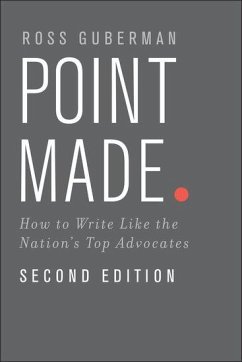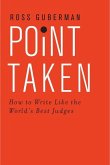Ross Guberman (President, President, Legal Writing Pro, Mclean, VA,
Point Made
How to Write Like the Nation's Top Advocates
Ross Guberman (President, President, Legal Writing Pro, Mclean, VA,
Point Made
How to Write Like the Nation's Top Advocates
- Broschiertes Buch
- Merkliste
- Auf die Merkliste
- Bewerten Bewerten
- Teilen
- Produkt teilen
- Produkterinnerung
- Produkterinnerung
In Point Made, Ross Guberman uses the work of great advocates as the basis of a valuable, step-by-step brief-writing and motion-writing strategy for practitioners. The author takes an empirical approach, drawing heavily on the writings of the nation's 50 most influential lawyers.
Andere Kunden interessierten sich auch für
![Point Taken Point Taken]() Ross Guberman (President, President, Legal Writing Pro)Point Taken36,99 €
Ross Guberman (President, President, Legal Writing Pro)Point Taken36,99 €![Ambiguity in EU Law Ambiguity in EU Law]() Sofiya KartalovaAmbiguity in EU Law37,99 €
Sofiya KartalovaAmbiguity in EU Law37,99 €![Forensic Linguistics in China Forensic Linguistics in China]() Yuan Chuanyou (Guangdong University of Foreign Studies)Forensic Linguistics in China77,99 €
Yuan Chuanyou (Guangdong University of Foreign Studies)Forensic Linguistics in China77,99 €![Law Dissertations Law Dissertations]() Laura LammasniemiLaw Dissertations73,99 €
Laura LammasniemiLaw Dissertations73,99 €![Forensic Linguistics in China Forensic Linguistics in China]() Yuan Chuanyou (Guangdong University of Foreign Studies)Forensic Linguistics in China25,99 €
Yuan Chuanyou (Guangdong University of Foreign Studies)Forensic Linguistics in China25,99 €![The Brussels Effect The Brussels Effect]() Anu Bradford (Henry L. Moses Professor of Law and International OrgThe Brussels Effect55,99 €
Anu Bradford (Henry L. Moses Professor of Law and International OrgThe Brussels Effect55,99 €![A History of the Supreme Court A History of the Supreme Court]() Bernard Schwartz (Chapman D Chapman Distinguished Professor of LawA History of the Supreme Court33,99 €
Bernard Schwartz (Chapman D Chapman Distinguished Professor of LawA History of the Supreme Court33,99 €-
-
-
In Point Made, Ross Guberman uses the work of great advocates as the basis of a valuable, step-by-step brief-writing and motion-writing strategy for practitioners. The author takes an empirical approach, drawing heavily on the writings of the nation's 50 most influential lawyers.
Hinweis: Dieser Artikel kann nur an eine deutsche Lieferadresse ausgeliefert werden.
Hinweis: Dieser Artikel kann nur an eine deutsche Lieferadresse ausgeliefert werden.
Produktdetails
- Produktdetails
- Verlag: Oxford University Press Inc
- 2 Revised edition
- Seitenzahl: 420
- Erscheinungstermin: 4. April 2014
- Englisch
- Abmessung: 210mm x 140mm x 23mm
- Gewicht: 520g
- ISBN-13: 9780199943852
- ISBN-10: 0199943850
- Artikelnr.: 39374088
- Herstellerkennzeichnung
- Books on Demand GmbH
- In de Tarpen 42
- 22848 Norderstedt
- info@bod.de
- 040 53433511
- Verlag: Oxford University Press Inc
- 2 Revised edition
- Seitenzahl: 420
- Erscheinungstermin: 4. April 2014
- Englisch
- Abmessung: 210mm x 140mm x 23mm
- Gewicht: 520g
- ISBN-13: 9780199943852
- ISBN-10: 0199943850
- Artikelnr.: 39374088
- Herstellerkennzeichnung
- Books on Demand GmbH
- In de Tarpen 42
- 22848 Norderstedt
- info@bod.de
- 040 53433511
Ross Guberman is president of Legal Writing Pro, an advanced legal-writing training and consulting firm. He has worked with thousands of attorneys at more than 100 of the world's largest and most prestigious law firms and for dozens of state and federal agencies and bar associations. Guberman is also a Professorial Lecturer in Law at The George Washington University Law School, and he holds degrees from Yale, the Sorbonne, and The University of Chicago Law School. Before founding Legal Writing Pro, Guberman worked as a musician, lawyer, translator, editor, and journalist. He has also commented on law, business, and lawyer development for major newspapers, radio stations, trade publications, and television networks, and he has addressed several major international conferences as well.
* Acknowledgments xxi
* Introduction xxiii
* PART ONE
* The Theme 1
* 1. Brass Tacks: "Explain who, what, when, where, why, how"
* 2. The Short List: Number your path to victory
* 3. Why Should I Care? : Give the court a reason to want to find for
you
* 4. Don't Be Fooled : Draw a line in the sand
* PART TWO
* The Tale
* 5. Panoramic Shot : Set the stage and sound your theme
* 6. Show, Not Tell : Let choice details speak for themselves
* 7. Once Upon a Time : Replace dates with phrases that convey a sense
of time
* 8. Headliners : Use headings to break up your fact section and to add
persuasive effect
* 9. Back to Life : Center technical matter on people or entities
* Interlude: Gauging your brief's readability
* 10. Poker Face : Concede bad facts, but put them in context
* 11. End with a Bang : Leave the court with a final image or thought
* PART THREE
* The Meat
* Using Headings
* 12. Russian Doll: Nest your headings and subheadings
* 13. Heads I Win, Tails You Lose : Argue in the alternative
* Interlude: Love "because"
* Structuring the Sections
* 14. Sneak Preview : Include an umbrella paragraph before your
headings and subheadings
* 15. Wish I Were There : Start each paragraph by answering a question
you expect the court to have
* 16. Sound Off : Start the paragraphs with numbered reasons
* Analogizing
* 17. Long in the Tooth : Say "me too"
* 18. Peas in a Pod : Link your party with the party in the cited case
* 19. Mince Their Words : Merge pithy quoted phrases into a sentence
about your own case
* 20. One Up : Claim that the case you're citing applies even more to
your own dispute
* 21. Interception : Claim that a case your opponent cites helps you
alone
* 22. Rebound : "Re-analogize" after the other side tries to
distinguish
* Distinguishing
* 23. Not Here, Not Now : Lead with the key difference between your
opponent's case and your own
* 24. One Fell Swoop : Distinguish a line of cases all at once
* 25. Not So Fast : Show that the case doesn't apply as broadly as your
opponent suggests
* 26. Authority Problems : Suggest that the case deserves little
respect
* Using Parentheticals
* 27. Ping Me : Introduce your parentheticals with parallel participles
* 28. Speak for Yourself : Include a single-sentence quotation
* 29. Hybrid Model : Combine participles and quotations
* Introducing Block Quotations
* 30. Lead 'Em On : Introduce block quotations by explaining how the
language supports your argument
* Using Footnotes
* Interlude: Citations in footnotes
* 31. Race to the Bottom : Use footnotes only in moderation to address
related side points and to add support
* PART FOUR
* The Words
* Liven Up the Language
* 32. Zingers : Colorful verbs
* 33. What a Breeze : Confident tone
* 34. Manner of Speaking : Figures of speech
* 35. That Reminds Me : Examples and analogies
* Jumpstart Your Sentences
* 36. The Starting Gate : The one-syllable opener
* 37. Size Matters : The pithy sentence
* 38. Freight Train : The balanced, elegant long sentence
* 39. Leading Parts : Two sentences joined as one
* 40. Talk to Yourself : The rhetorical question
* 41. Parallel Lives : The parallel construction
* Creative Punctuation
* 42. A Dash of Style : The dash
* Interlude: The hyphen
* 43. Good Bedfellows : The semicolon
* 44. Magician's Mark : The colon
* Seamless Flow
* 45. Take Me by the Hand : Logical connectors
* 110 Transition Words and Phrases
* 46. Bridge the Gap : Linked paragraphs
* Visual Appeal
* Interlude: Looking good
* 47. Join My Table : Tables and charts
* 48. Bullet Proof : Bullet points and lists
* PART FIVE
* The Close
* The Last Word
* 49. Parting Thought : End the argument with a provocative quotation
or pithy thought
* 50. Wrap-Up : Recast your main points in a separate conclusion
* Appendices
* The Top Fifty Advocates: Biographies
* How to Write the Perfect Brief: Fifty Techniques
* Step One: The Theme
* Step Two: The Tale
* Step Three: The Meat
* Step Four: The Words
* Step Five: The Close
* Twenty Best Quotes from Judges
* Annotated Models
* Before-and-after section from Jones v. Clinton
* Alaska v. EPA
* MercExchange v. eBay
* Index
* Introduction xxiii
* PART ONE
* The Theme 1
* 1. Brass Tacks: "Explain who, what, when, where, why, how"
* 2. The Short List: Number your path to victory
* 3. Why Should I Care? : Give the court a reason to want to find for
you
* 4. Don't Be Fooled : Draw a line in the sand
* PART TWO
* The Tale
* 5. Panoramic Shot : Set the stage and sound your theme
* 6. Show, Not Tell : Let choice details speak for themselves
* 7. Once Upon a Time : Replace dates with phrases that convey a sense
of time
* 8. Headliners : Use headings to break up your fact section and to add
persuasive effect
* 9. Back to Life : Center technical matter on people or entities
* Interlude: Gauging your brief's readability
* 10. Poker Face : Concede bad facts, but put them in context
* 11. End with a Bang : Leave the court with a final image or thought
* PART THREE
* The Meat
* Using Headings
* 12. Russian Doll: Nest your headings and subheadings
* 13. Heads I Win, Tails You Lose : Argue in the alternative
* Interlude: Love "because"
* Structuring the Sections
* 14. Sneak Preview : Include an umbrella paragraph before your
headings and subheadings
* 15. Wish I Were There : Start each paragraph by answering a question
you expect the court to have
* 16. Sound Off : Start the paragraphs with numbered reasons
* Analogizing
* 17. Long in the Tooth : Say "me too"
* 18. Peas in a Pod : Link your party with the party in the cited case
* 19. Mince Their Words : Merge pithy quoted phrases into a sentence
about your own case
* 20. One Up : Claim that the case you're citing applies even more to
your own dispute
* 21. Interception : Claim that a case your opponent cites helps you
alone
* 22. Rebound : "Re-analogize" after the other side tries to
distinguish
* Distinguishing
* 23. Not Here, Not Now : Lead with the key difference between your
opponent's case and your own
* 24. One Fell Swoop : Distinguish a line of cases all at once
* 25. Not So Fast : Show that the case doesn't apply as broadly as your
opponent suggests
* 26. Authority Problems : Suggest that the case deserves little
respect
* Using Parentheticals
* 27. Ping Me : Introduce your parentheticals with parallel participles
* 28. Speak for Yourself : Include a single-sentence quotation
* 29. Hybrid Model : Combine participles and quotations
* Introducing Block Quotations
* 30. Lead 'Em On : Introduce block quotations by explaining how the
language supports your argument
* Using Footnotes
* Interlude: Citations in footnotes
* 31. Race to the Bottom : Use footnotes only in moderation to address
related side points and to add support
* PART FOUR
* The Words
* Liven Up the Language
* 32. Zingers : Colorful verbs
* 33. What a Breeze : Confident tone
* 34. Manner of Speaking : Figures of speech
* 35. That Reminds Me : Examples and analogies
* Jumpstart Your Sentences
* 36. The Starting Gate : The one-syllable opener
* 37. Size Matters : The pithy sentence
* 38. Freight Train : The balanced, elegant long sentence
* 39. Leading Parts : Two sentences joined as one
* 40. Talk to Yourself : The rhetorical question
* 41. Parallel Lives : The parallel construction
* Creative Punctuation
* 42. A Dash of Style : The dash
* Interlude: The hyphen
* 43. Good Bedfellows : The semicolon
* 44. Magician's Mark : The colon
* Seamless Flow
* 45. Take Me by the Hand : Logical connectors
* 110 Transition Words and Phrases
* 46. Bridge the Gap : Linked paragraphs
* Visual Appeal
* Interlude: Looking good
* 47. Join My Table : Tables and charts
* 48. Bullet Proof : Bullet points and lists
* PART FIVE
* The Close
* The Last Word
* 49. Parting Thought : End the argument with a provocative quotation
or pithy thought
* 50. Wrap-Up : Recast your main points in a separate conclusion
* Appendices
* The Top Fifty Advocates: Biographies
* How to Write the Perfect Brief: Fifty Techniques
* Step One: The Theme
* Step Two: The Tale
* Step Three: The Meat
* Step Four: The Words
* Step Five: The Close
* Twenty Best Quotes from Judges
* Annotated Models
* Before-and-after section from Jones v. Clinton
* Alaska v. EPA
* MercExchange v. eBay
* Index
* Acknowledgments xxi
* Introduction xxiii
* PART ONE
* The Theme 1
* 1. Brass Tacks: "Explain who, what, when, where, why, how"
* 2. The Short List: Number your path to victory
* 3. Why Should I Care? : Give the court a reason to want to find for
you
* 4. Don't Be Fooled : Draw a line in the sand
* PART TWO
* The Tale
* 5. Panoramic Shot : Set the stage and sound your theme
* 6. Show, Not Tell : Let choice details speak for themselves
* 7. Once Upon a Time : Replace dates with phrases that convey a sense
of time
* 8. Headliners : Use headings to break up your fact section and to add
persuasive effect
* 9. Back to Life : Center technical matter on people or entities
* Interlude: Gauging your brief's readability
* 10. Poker Face : Concede bad facts, but put them in context
* 11. End with a Bang : Leave the court with a final image or thought
* PART THREE
* The Meat
* Using Headings
* 12. Russian Doll: Nest your headings and subheadings
* 13. Heads I Win, Tails You Lose : Argue in the alternative
* Interlude: Love "because"
* Structuring the Sections
* 14. Sneak Preview : Include an umbrella paragraph before your
headings and subheadings
* 15. Wish I Were There : Start each paragraph by answering a question
you expect the court to have
* 16. Sound Off : Start the paragraphs with numbered reasons
* Analogizing
* 17. Long in the Tooth : Say "me too"
* 18. Peas in a Pod : Link your party with the party in the cited case
* 19. Mince Their Words : Merge pithy quoted phrases into a sentence
about your own case
* 20. One Up : Claim that the case you're citing applies even more to
your own dispute
* 21. Interception : Claim that a case your opponent cites helps you
alone
* 22. Rebound : "Re-analogize" after the other side tries to
distinguish
* Distinguishing
* 23. Not Here, Not Now : Lead with the key difference between your
opponent's case and your own
* 24. One Fell Swoop : Distinguish a line of cases all at once
* 25. Not So Fast : Show that the case doesn't apply as broadly as your
opponent suggests
* 26. Authority Problems : Suggest that the case deserves little
respect
* Using Parentheticals
* 27. Ping Me : Introduce your parentheticals with parallel participles
* 28. Speak for Yourself : Include a single-sentence quotation
* 29. Hybrid Model : Combine participles and quotations
* Introducing Block Quotations
* 30. Lead 'Em On : Introduce block quotations by explaining how the
language supports your argument
* Using Footnotes
* Interlude: Citations in footnotes
* 31. Race to the Bottom : Use footnotes only in moderation to address
related side points and to add support
* PART FOUR
* The Words
* Liven Up the Language
* 32. Zingers : Colorful verbs
* 33. What a Breeze : Confident tone
* 34. Manner of Speaking : Figures of speech
* 35. That Reminds Me : Examples and analogies
* Jumpstart Your Sentences
* 36. The Starting Gate : The one-syllable opener
* 37. Size Matters : The pithy sentence
* 38. Freight Train : The balanced, elegant long sentence
* 39. Leading Parts : Two sentences joined as one
* 40. Talk to Yourself : The rhetorical question
* 41. Parallel Lives : The parallel construction
* Creative Punctuation
* 42. A Dash of Style : The dash
* Interlude: The hyphen
* 43. Good Bedfellows : The semicolon
* 44. Magician's Mark : The colon
* Seamless Flow
* 45. Take Me by the Hand : Logical connectors
* 110 Transition Words and Phrases
* 46. Bridge the Gap : Linked paragraphs
* Visual Appeal
* Interlude: Looking good
* 47. Join My Table : Tables and charts
* 48. Bullet Proof : Bullet points and lists
* PART FIVE
* The Close
* The Last Word
* 49. Parting Thought : End the argument with a provocative quotation
or pithy thought
* 50. Wrap-Up : Recast your main points in a separate conclusion
* Appendices
* The Top Fifty Advocates: Biographies
* How to Write the Perfect Brief: Fifty Techniques
* Step One: The Theme
* Step Two: The Tale
* Step Three: The Meat
* Step Four: The Words
* Step Five: The Close
* Twenty Best Quotes from Judges
* Annotated Models
* Before-and-after section from Jones v. Clinton
* Alaska v. EPA
* MercExchange v. eBay
* Index
* Introduction xxiii
* PART ONE
* The Theme 1
* 1. Brass Tacks: "Explain who, what, when, where, why, how"
* 2. The Short List: Number your path to victory
* 3. Why Should I Care? : Give the court a reason to want to find for
you
* 4. Don't Be Fooled : Draw a line in the sand
* PART TWO
* The Tale
* 5. Panoramic Shot : Set the stage and sound your theme
* 6. Show, Not Tell : Let choice details speak for themselves
* 7. Once Upon a Time : Replace dates with phrases that convey a sense
of time
* 8. Headliners : Use headings to break up your fact section and to add
persuasive effect
* 9. Back to Life : Center technical matter on people or entities
* Interlude: Gauging your brief's readability
* 10. Poker Face : Concede bad facts, but put them in context
* 11. End with a Bang : Leave the court with a final image or thought
* PART THREE
* The Meat
* Using Headings
* 12. Russian Doll: Nest your headings and subheadings
* 13. Heads I Win, Tails You Lose : Argue in the alternative
* Interlude: Love "because"
* Structuring the Sections
* 14. Sneak Preview : Include an umbrella paragraph before your
headings and subheadings
* 15. Wish I Were There : Start each paragraph by answering a question
you expect the court to have
* 16. Sound Off : Start the paragraphs with numbered reasons
* Analogizing
* 17. Long in the Tooth : Say "me too"
* 18. Peas in a Pod : Link your party with the party in the cited case
* 19. Mince Their Words : Merge pithy quoted phrases into a sentence
about your own case
* 20. One Up : Claim that the case you're citing applies even more to
your own dispute
* 21. Interception : Claim that a case your opponent cites helps you
alone
* 22. Rebound : "Re-analogize" after the other side tries to
distinguish
* Distinguishing
* 23. Not Here, Not Now : Lead with the key difference between your
opponent's case and your own
* 24. One Fell Swoop : Distinguish a line of cases all at once
* 25. Not So Fast : Show that the case doesn't apply as broadly as your
opponent suggests
* 26. Authority Problems : Suggest that the case deserves little
respect
* Using Parentheticals
* 27. Ping Me : Introduce your parentheticals with parallel participles
* 28. Speak for Yourself : Include a single-sentence quotation
* 29. Hybrid Model : Combine participles and quotations
* Introducing Block Quotations
* 30. Lead 'Em On : Introduce block quotations by explaining how the
language supports your argument
* Using Footnotes
* Interlude: Citations in footnotes
* 31. Race to the Bottom : Use footnotes only in moderation to address
related side points and to add support
* PART FOUR
* The Words
* Liven Up the Language
* 32. Zingers : Colorful verbs
* 33. What a Breeze : Confident tone
* 34. Manner of Speaking : Figures of speech
* 35. That Reminds Me : Examples and analogies
* Jumpstart Your Sentences
* 36. The Starting Gate : The one-syllable opener
* 37. Size Matters : The pithy sentence
* 38. Freight Train : The balanced, elegant long sentence
* 39. Leading Parts : Two sentences joined as one
* 40. Talk to Yourself : The rhetorical question
* 41. Parallel Lives : The parallel construction
* Creative Punctuation
* 42. A Dash of Style : The dash
* Interlude: The hyphen
* 43. Good Bedfellows : The semicolon
* 44. Magician's Mark : The colon
* Seamless Flow
* 45. Take Me by the Hand : Logical connectors
* 110 Transition Words and Phrases
* 46. Bridge the Gap : Linked paragraphs
* Visual Appeal
* Interlude: Looking good
* 47. Join My Table : Tables and charts
* 48. Bullet Proof : Bullet points and lists
* PART FIVE
* The Close
* The Last Word
* 49. Parting Thought : End the argument with a provocative quotation
or pithy thought
* 50. Wrap-Up : Recast your main points in a separate conclusion
* Appendices
* The Top Fifty Advocates: Biographies
* How to Write the Perfect Brief: Fifty Techniques
* Step One: The Theme
* Step Two: The Tale
* Step Three: The Meat
* Step Four: The Words
* Step Five: The Close
* Twenty Best Quotes from Judges
* Annotated Models
* Before-and-after section from Jones v. Clinton
* Alaska v. EPA
* MercExchange v. eBay
* Index








